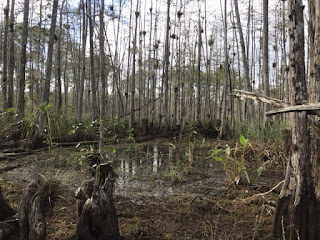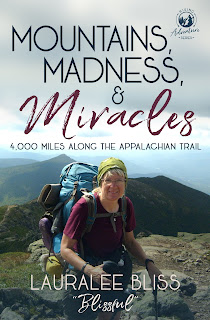With the publishing of my trail adventure Gators Guts and Glory - Adventures Along the Florida Trail - the second in the Hiking Adventure Series - I decided to take you back to the beginning of the adventure on memory lane (or in this case, trail) -
Check out my book on this 1100 mile adventure On Amazon!
The Florida Trail is quickly becoming an interesting trail to traverse during the winter months when other trails are besieged by frigid temps and snowy conditions. One is transported to a land of plentiful sunshine and warm temps reminiscent of summer wanders. Prime time to begin the Florida Trail is December and January. But despite the seemingly flat terrain on elevation profiles, there are multiple challenges one endures.
Check out my book on this 1100 mile adventure On Amazon!
"What a great book! I couldn't put it down." - Amazon review, Verified Purchase
"This is a must read. Lauralee's writing style keeps you riveted to her every mile..." - Amazon review, Verified Purchase
The Florida Trail is quickly becoming an interesting trail to traverse during the winter months when other trails are besieged by frigid temps and snowy conditions. One is transported to a land of plentiful sunshine and warm temps reminiscent of summer wanders. Prime time to begin the Florida Trail is December and January. But despite the seemingly flat terrain on elevation profiles, there are multiple challenges one endures.
The Beginning
The southern terminus for the trail is the Oasis Visitor
Center in the Big Cypress National Preserve.
Overseen by the National Park
Service, it has a visitor center complex with friendly rangers (unfortunately the
one we spoke to did NOT have up to day info for us on trail conditions and
claimed the tent sites had tables and fire pits which none do in the swamp area),
restrooms, a little walkway that shows off their alligator, a nice big plaque
to get the proverbial first day picture taken, and a log book to sign in with
excitement for that first day. They also allow you to park there.
The first two days in the swamp area were fairly dry
and interesting. We saw vast prairies that reminded me of Africa. Of course
there
was the issue of trying to get used to overloaded backpacks that still made the
going rather slow.
Another thing one has to learn how to do is find water in
the swamp. Especially when the area where you are walking is dry (and there are
no streams). We quickly became acquainted with what is known as a Cypress Dome –
a curved stand of tall like trees that jut out above the land. In the middle of
that configuration of trees is usually a water source. We found one such source
for our first night after trudging through muddy cypress stands to find the water
in the middle of the dome. On the second day water become even scarcer and for
the first time I used the directions for the dome in my guidebook and managed
to stumble upon the water (and wow, did I thank God for that find!). Swamp water
unfortunately does not taste good at all (despite what the ranger told us). It
has a distinctly weird
 |
| Water Source in a Cypress Dome |
We did not end up doing our projected miles as the terrain
slowed us down, and slowed us even further once we actually reached water.
After a particular fenceline, you are then wading in water for miles on end with
only small areas to rest or camp. It is a slow, arduous process, and in this
area mud quickly fills your shoes, hides obstacles (like Cypress roots and
limestone holes) so that it is hard to keep your footing. I was forever
stopping and scraping mud out of my shoes that accumulated inside and made the
bottoms of my feet hurt. On the small blotches of land
 |
| The Black Lagoon |
In the water the best we could do was 7/10 mile an hour. It was
a slow achingly long process. But at last we cleared the swamp to rest at a literal
rest area on Alligator Alley before continuing on.
What I learned:
Know how to get your water in those interesting Cypress Domes!
It’s the only place out there until
 |
| Swamp Camping |
Do not plan any high miles. Take your time sloshing your way
through. If you are in a wet year, monitor the swamp depths and come prepared with
dry bags for your gear. (I happened to hike it in a dry year – Dec 2016, so the
deepest part at the Black Lagoon was only knee deep. But it can get waist deep
or higher sometimes).
Know your shoe will get destroyed there, so plan to have
shoes waiting for you farther up the trail
Use hiking poles in the swamp
Try to dry out your feet as much as you can. I found blister
blockers from Band-Aid to stay on even when wet. Try to get the mud out of your
shoes to prevent strain on your foot muscles. Take plenty of socks. I also washed
the mud out my shoes when I could (as the mud can make them weigh a lot).
Yes there are sand fleas out there as well as mosquitoes. Protect
yourself with Deet or the equivalent.
We did not see gators or snakes on this section,
but we did see other wildlife like deer and a bobcat.
I found the Guthook Florida Trail app to be very useful. But
the trail is also fairly well blazed or one can simply follow the track of
water.
If you are in hunting season, wear blaze orange for the
first part of the trail. Hunters are out there, believe it or not, and ride around
in swamp vehicles.
Know that the swamp WILL end and you will have plenty of
interesting memories and pictures to share!
Resources:
Florida Hikes website - for the guidebook and also, check out this thorough review on my Florida Trail Adventure!
Florida Trail Association - maps and advice
Book 1 in the Hiking Adventure Series - Mountains, Madness and Miracles
Book 1 in the Hiking Adventure Series - Mountains, Madness and Miracles




No comments:
Post a Comment